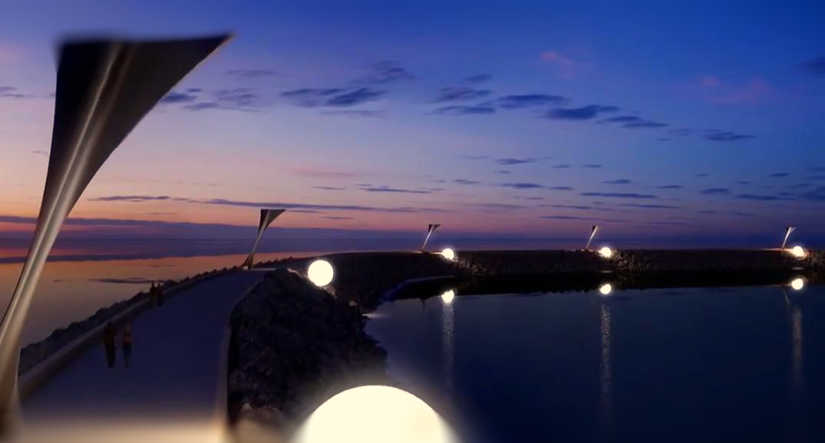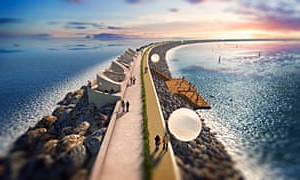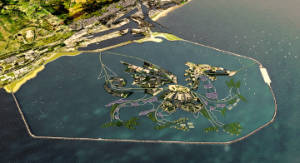Swansea Tidal Lagoon: News & details on bay proposal

The tidal power project on Swansea Bay has the potential to change the tide when it comes to the development of renewable energy in the UK for decades to come. By combining the environmental and energy efficiency benefits of renewables with the predictability of tidal currents, this large-scale endeavour certainly has promise. Take a look at our in-depth look at how this engineering marvel can help Britain's green energy ambitions.
Latest Swansea Bay tidal lagoon news
Tidal Power Plc has been developing its idea for a tidal lagoon hydropower station in Swansea Bay for over a decade.
The first tidal lagoon in Swansea Bay would serve as a prototype for the construction of larger and even more efficient tidal power lagoons elsewhere and add to the UK’s renewable energy mix.
However, in 2018 the UK government decided the plant would not provide value-for-money and withdrew its support leaving developers high and dry.
The pilot project promises to generate enough energy for between 120,000 and 150,000 homes and meet about 11% of Welsh domestic electricity demand.

Supporters of the project argue it will provide sustainable energy for 120 years, double any other power station’s lifespan, and serve as a seed to grow an industry that could sell its expertise globally, far away from British shores, bringing in much needed revenue into the Welsh economy.
The technology behind the tidal energy project is relatively simple. Twice a day at each high tide, an artificial lagoon is filled up with sea water. As the water enters or leaves it turns turbines which generate predictable, reliable and very low-carbon electricity four times a day, at both high and low tides.
What is tidal power?Tidal energy is a type of hydroelectric power technology which allows clean energy to be generate from the kinetic energy of tides. Government policy has meant tidal energy is far behind other forms of renewable energy in the UK.
Tidal lagoon power proposal
Although the company behind the Swansea Tidal Lagoon received planning permission in 2015, that runs out in June of this year unless “material works” have started on the project.
As it has not yet been able to obtain a licence for marine construction, the company is in the process of securing £1.2m to begin work on dry land where it already has agreements with landowners.
Following Westminster’s abandonment of the plan, Swansea-based Tidal Power Plc decided to take the unusual step of pushing ahead without government support.
It has been trying to drum up financing from the private sector through power purchase agreements (PPAs) and is consulting with firms in the media, services, telecoms, utilities and manufacturing industries to bolster the economic argument for the Swansea tidal lagoon project.

PPA contracts are often used to guarantee customer-supplier relationships over decades to help finance independent renewable energy projects and are used by organizations as a buffer against future price rises.
The plan has also been revised to include floating solar panels to increase the Swansea tidal lagoon project’s energy output from 572 gigawatt hours (GWh) to around 770 GWh.
Tidal Power Plc hopes to be able to announce a final investment decision and begin construction soon with a view to producing electricity by 2024 or 2025.
How is Swansea Tidal Lagoon being funded?
Development of the project has so far cost around £35m. Although the Welsh government provided a £1.25m loan, the rest of the funding has been raised from private sources.
Key investors include InfraRed Capital Partners, Prudential and the Gupta family. Renewable energy company Good Energy is another stakeholder and there are around 350 more individual investors.
If the greenlight is given to begin construction, the four-year effort is budgeted at £1.3bn creating more than 2,200 jobs and adding £316m to the Welsh economy during construction.
Once completed, it is hoped to continue contributing £76m per year to the local economy over its 120-year lifespan.
The firm behind the project had wanted a 90-year contract with the UK government with a guaranteed average price for the electricity (average strike price) of £89.90 per MWh.
A strike-price is a guarantee for investors that they will be able to get a return on their money.
This price would have started at £123 per MWh for the first year and eventually would have fallen to £43 per MWh after 90 years and, if the lagoon meets its life expectancy of 120 years, the plant would provide energy for zero cost in its final decades.
Larger-scale lagoons planned in the future would use economies of scale to provide energy for even less by passing greater volumes of water through their turbines.
The average strike price asked for Swansea Tidal Lagoon would have been slightly lower than the 35-year agreed price of £92.50 per MWh for the Hinkley Point C nuclear plant in Somerset.
However, the government was heavily criticized for this agreement and has told newer projects to expect less generous contracts. Recent offshore wind projects won strike prices of just £57.50 per MWh for 15 years.
The Swansea Lagoon strike-price would have been paid by energy users on their bills.
According to Tidal Power Plc, the rate of required support from customers would have been about the same as for nuclear and, as the project is small scale, 20-30p per household per year could have funded it.
Why did the UK government withdraw support for the Swansea Tidal Lagoon?
The government disagreed with the way the Swansea tidal lagoon costs had been estimated.
Rather than looking just at the Swansea pilot project, the government added up the cost of the eventual total of six lagoons planned and arrived at a figure of around £50bn.
The six lagoons together would generate roughly the same amount of power as the £20.3bn Hinkley C nuclear plant. So, from this perspective the Swansea project and its brethren would cost more than twice as much and didn’t look like very good value for money.
A brief history of Swansea Tidal Lagoon
2003
The germ of an idea begins as renewable energy charity the Environment Trust proposes a £30m tidal lagoon to power 10,000 homes.
2006
Tidal Electric Ltd expresses interest in pursuing the project but this proposal eventually goes nowhere.
2011
The project begins to coalesce as early feasibility studies are carried out along with consultations with local and national stakeholders.
2012
More groundwork is laid as a breakwater and power generation project is announced by Tidal Lagoon Power.
While various designs and solutions are investigated, initial assessment of the plan’s environmental impact starts.
2014
Things start to become official as permission for an £850m development is sought from the Planning Inspectorate along with a Marine Licence application from Natural Resources Wales and Prudential comes on board as a major investor. Swansea Bay lagoon is included as part of the 2014 UK National Infrastructure Plan.
2015
This is the year when the future of the project seemed to solidify.
The Planning Inspectorate approves the development order, InfraRed Capital Partners come on board as another major investor and various firms including General Electric and Andritz Hydro are announced as preferred bidders for the construction and manufacturing phases.
The project is put before European Union energy ministers, presented at at COP21, the 2015 Paris Climate Conference and promoted around the world.
2016
The project is included in the 2015 Conservative Party election manifesto and polls find 83% of Conservative MPs in support.
Former energy minister Charles Hendry is given the job of conducting an independent review of the project’s feasibility.
2017
In 2017, it seems getting the go-ahead is all-but-inevitable.
Charles Hendry’s review backs the pilot project and estimates the cost at about 30p per household per year over the first three decades.
Hendry recommends starting the pilot project “as swiftly as possible”, highlighting the energy security and business opportunities along with the competitive decarbonisation benefits of the technology.
“Having looked at all the evidence, spoken to many of the key players, on both sides of this debate, it is my view that we should seize the opportunity to move this technology forward now,” he said.
2018
Months after the Hendry review and stakeholders are growing pessimistic due to the lack of a decision from the UK government.
To nudge London in the right direction, the Welsh First Minister pledges £200m towards the construction.
The announcement that the UK government does not consider the project to be good value for money and would not be agreeing to the strike-price requested by Tidal Power Plc comes shortly thereafter.
The Swansea Tidal Lagoon supporters go back to the drawing board.
2019
With the clock ticking down to the planning permission lapsing in June 2020 the company tries to raise £1.2m to start work on dry land.
Alternative plans are put forward to attract investors, including one for a floating "Dragon Energy Island" with up to 10,000 homes being built on the lagoon itself. The homes would receive free energy for 120 years.
The technology behind the Swansea Tidal Lagoon
A tidal lagoon is created by building a wall out from the shore into the water and back to the shore again forming a U-shaped “breakwater”.

The wall creates the lagoon which fills up as the tides rise. At Swansea, a 9.5km breakwater wall will enclose 11.5 square kilometers to create the lagoon.
Turbines built into the wall produce electricity as the lagoon fills up and empties four times a day with the high and low tides, turning the potential energy of the water into electric energy for the grid.
The plan is for the 7.2m-diameter turbines to be built at factories in Wales. The project involves 16 units providing an installed capacity of 320MW which would yield a guaranteed 530GWh of electricity annually, enough to power 155,000 homes every year for 120 years.
The turbines will be bi-directional, low head, Kaplan bulb hydro turbines to be built by General Electric and Andritz Hydro under a £300m contract.
This type of turbine is common and used in hundreds of hydro projects around the world, but the design for Swansea has been adapted to be much more efficient and easier to mass-produce for future projects.
The amount of energy extracted by tidal power projects over a year is called the “E-max”. At present the typical tidal barrage project using bulb turbines can capture around 20% of the E-max.
The state-of-the-art turbines for Swansea are far more efficient and are designed to allow the plant to extract almost 60% of the E-max.
The design also incorporates variable speed generator technology meaning they can help the project operate more sensitively according to local ecosystems and respond to fluctuating grid demand, making them suitable for installation in sites all over the world.
An estimated 100,000 tonnes of steel will be used in the construction and manufacturing of the project.
Why has the Severn Estuary been chosen for the Swansea Tidal Lagoon?
The coastline around Great Britain has some of the highest tides in the world and the difference between high tide and low tide in Swansea Bay is between 7 and 9 metres.
The bay also enjoys a shallow seabed that slopes gently making it suitable for construction.
These attributes make the Severn Estuary a perfect location for building a tidal lagoon.
If Swansea’s gates were closed for only three hours the difference between the water levels outside and inside the lagoon could reach 4m.
Once the gates were opened, the water would rush through 60m-long tubes driving the hydro turbines to produce electricity.
About 100,000 Olympic swimming pools-worth of water would pass through the turbines every day.
What else will Swansea Tidal Lagoon offer?
The developers don’t see the lagoon being just an out of the way power plant, they envision it as a community hub and tourist destination providing opportunities for sports, the arts and businesses.

The seawall will be open for walkers, cyclists and joggers to enjoy the sea air and scenery. A beach with rock pools is planned, along with a playground and space for art installations. A visitor's centre will let the public learn about tidal energy and provide resources for schools.
The company has promised a boating centre and will allow swimming, sailing, rowing and canoeing on the lagoon itself.
Local companies will be invited to explore ways of creating marine aquaculture businesses such as farming seaweed or shellfish.
What is the likely environmental impact of the Swansea Tidal Lagoon?
While supporters estimate 236,000 tonnes of carbon will be kept out of the atmosphere by the plant, aiding the fight against the climate emergency, its environmental impact is not necessarily all positive.
Although Tidal Lagoon Power is concentrating on the financial side of things to secure the future of the project, a huge barrier remains.
Six years after it first applied, the firm still doesn’t have a marine license from Natural Resources Wales, suggesting the regulator is yet to be convinced the project can be done with a minimal cost to the local ecosystem.
The environmental impact assessment found that the plant could affect fish in the area and local anglers are worried about its impact on their hobby, with fishing in the rivers around Swansea and as well as sea trout and salmon fishing in the River Usk being their prime concern.
Another danger is the potential for fish to be sucked into the turbines. The studies done show that the risk of being caught in the turbines for most species is less than 1% and less than 3% for all species. The variable speed technology of the turbines is put forward as a way to minimize this number.

However, the project will also unavoidably impact fish spawning, nursery and feeding areas. The firm promises to work to mitigate the lagoon’s impact on fish life.
Birdlife, marine mammals and invertebrates could also be impacted by the lagoon in various ways, both positive and negative.
On the plus side, the sea wall could provide new habitats for crustaceans and offer a safe place for fish hatcheries.
Birds could be attracted by the calmer waters of the intertidal areas providing protection from the harsher environment of the open bay. Tidal Lagoon Power have worked with British Trust for Ornithology to research bird life in the area and study the likely impact of the development.
Mammals may fare worse if the plant goes ahead. A study of records by Tidal Lagoon Power found that harbour porpoise and grey seal were the most common marine mammals seen in the Severn Estuary.
The construction of the lagoon will expose these animals to risks of collision and an increase in navigation-disrupting noise pollution. It will introduce barriers to their movement as well as affecting their habitat’s water quality and available food sources. The company said it will monitor the animals via underwater microphones to identify any changes in behaviour.
Is Swansea Tidal Lagoon the only project of its type?
If Tidal Lagoon Power manages to finally get Swansea up and running, it has five bigger lagoons in the pipeline at Cardiff, Colwyn Bay, Bridgwater, Newport and West Cumbria.
Other companies are exploring the potential of tidal lagoons too.
Ecotricity has proposed offshore lagoons built in estuaries rather than being built out from the shore.
Tidal Electric, the firm which first looked at the Swansea project way back in 2006, are working on an offshore lagoon for Scotland.
Meanwhile, back in Wales a £7bn tidal project that doubles as a protection against floods is being developed by North Wales Tidal Energy in Colwyn Bay, St Asaph and Rhyl.
Is Swansea Tidal Lagoon a viable option?
The UK government rejected the proposal as being poor value-for-money leaving it in limbo.
However, the comparison of the cost of producing electricity is far from straightforward.
For example, while Hinkley C has a life-span of 60 years, the lagoon plant should be running for at least twice that time scale.
Moreover, the price of wholesale electricity can change hour by hour and can fluctuate widely over days, making cost comparisons even more complicated.
On top of that there is the question of what price to put on disposing of nuclear waste or the risk of nuclear accidents, problems a tidal lagoon doesn’t suffer from.
There’s also a lot to be said for diversifying the nation’s energy mix in terms of building up knowledge and expertise, ensuring energy security and in reducing reliance on such a controversial technology as nuclear energy.
While the Swansea Tidal Lagoon may eventually aid the UK’s transition to a net-zero carbon economy, there are many suppliers which already offer low-cost clean, green, renewable energy. Click here to find out how we can help you to make the switch quickly and easily.
by Damien McCrossan
